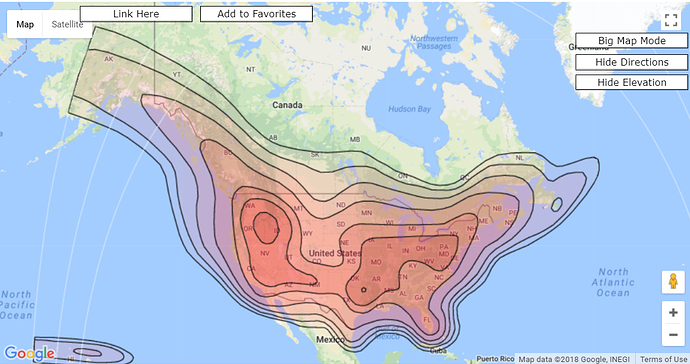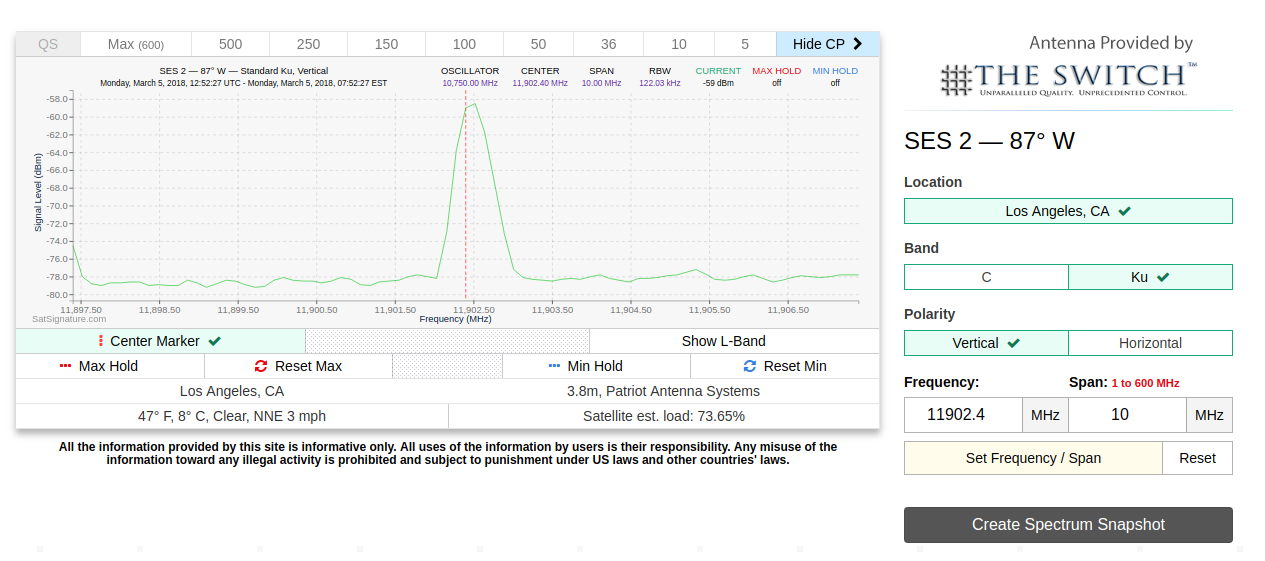@ac8dg Our contract manufacturer is acquiring parts for a 900-piece production run right now. The normal rhythm is two weeks to get all of the parts and then one week to build the boards (solder the components). And then four days for shipping. It’s not impossible that I would have 900 units of v3.03 on hand by the end of the month. The current hardware version is v3.02.
@239Adastrea Yes, if enabled, your Dreamcatcher will report SNR and location to a public webpage.
Nope, C-band is on 4-8 GHz. The SES-2 satellite has a C-band transponder at 3750-4200 MHz. It’s pretty clear that they are moving Hughes somewhere and parting-out the TP10 transponder to you and other SCPC customers. Are you sure you are on vertical polarization? In the preview picture, your LNB was laying down sideways. Normally 13v bias is vertical, 18v is horizontal. Transponders do overlap in frequencies with neighboring odd/even numbered transponders.
So no Skylark images to fix software bugs? Ouch. So there’s nothing to gain to help finding bugs. We will have to buy a new board for an update? Wow.
–Konrad, WA4OSH
I think the map you posted was not correct. Purple indicates C-band. Red is for Ku. This is the coverage map for SES-2 Ku NA.
No, no. A new board is not at all required for updated images. They are simply burned to the microSD card, similar to Raspbian images on a Pi.
OK … I now understand what you meant by map. Yes, the coverage map.
I would like to know the correct polarization - Vertical or Horizontal? That and the center frequency will tell us which transponder we are on.
–Konrad, WA4OSH
It is vertical at 11902.4 MHz.
I guess my question is if this locked into a specific frequency etc for a specific satellite…as I remember the old boards were locked at around 1.5ghz?
The old boards were not locked; they had two ports. The first port did have a SAW filter and LNA for the 1525 - 1559 band. The second port allowed for the RTL-SDR to cover it’s entire normal range.
Dreamcatcher 3 has a similar two-port approach. The first is for a wide range of frequencies (more on that later). The second port is for direct 2.4 GHz usage.
Thanks, I’ll wait.
Then Hughes Net can’t be on TP 10 anymore, or are only renting 30 MHz of it and Outernet is the lower 6 MHz of it? Makes total sense.
–Konrad, WA4OSH
Please don’t exclude me! I’m very interested in this system. I have a technical background and can help with feedback. I don’t have a problem purchasing this as well as the production unit. I’d like to see if this could be something used out at sea where the only other option to get grib files would be to purchase thousands of dollars worth of equipment. I’d like to see if I need a gimbal system too.
Also, if you still have any l-band patch antennas from the previous system to sell, please send me a link to purchase. I would like a few of these in order to connect to Inmarsat’s SafetyNet with an sdr.
Thank you!!!
Right, The old one was just below the 1.575ghz for GPS. I don’t need another RTL-SDR…but this IS an SDR. I just want to know roughly the freq range… and I do have a use for the 2.4ghz also… However, if others need it more, I can wait.
Syed,
Its the KTV Beam right? I’m in Edmonton, so:
EIRP level = 44 dBW
Recommended dish size = 90cm / 35.4in
So using my dish-less LNBF set to Vertical, and pointing in the right direction, I would tune my SDR to 1109.4 MHz with SDR# software, I should see a carrier? Wow, at least a first step for me if it works! Then, I’ll get DC v3.03 and fly onward and upward. 
Thanks Syed … 73
Dear Syed
May be I do not understanding many terms in your message, anyway is this ready unit can receive internet from Satellite ? is it works in united Arab Emirate and Saudi Arabia ?
Please advise
Regards
Ibrahim
Hi,
Outernet is not Internet, You CANT request data because you only have a download but not an upload channel, just to make that clear.
At the Moment there is only one Satellite Beam in the USA, so you CANT receive it where you live.
There will be more satellite coverage in the future that will cover your Region as well.
So you should wait until there is satellite coverage in your area.
regards,
Manuel
Just for your Information: The DC3 doesen’t use an SDR Chip, it has an SX1280 transreceiver in it with a Center frequency of 2.4ghz.
Donde,
The Outernet signal is below noise level without a dish and just an RTL-SDR. You may need a dish to “pull it out of the weeds”. With a spectrum analyzer and a low enough resolution bandwidth, you can see it.
In fact, you can definitely see it here: Outernet signal on SatSignature.com
–Konrad, WA4OSH
I’m in the Seattle area. According to Satbeams they predict…
EIRP level = 50 dBW
Recommended dish size = 60cm / 23.6in
Keep in mind the recommended dish size is for receiving a TV signal. The Outernet signal is much narrower bandwidth and sent using a spread-spectrum signal. The signal can be recovered from under the noise using process gain in the receiver.
Your signal will be 6 dB down from mine in the Seattle area. IMHO, you have two options,
- Try it, risk having a terrible signal without a dish, and if it’s not enough signal to lock, get a small dish to help you.
- See how other people do around the country, determine if there’s enough signal and get a later revision of the board. Then you still have to risk errors in this signal prediction software. If it’s not enough signal, you will probably have to get some gain on the receiver with a small dish.
–Konrad, WA4OSH

